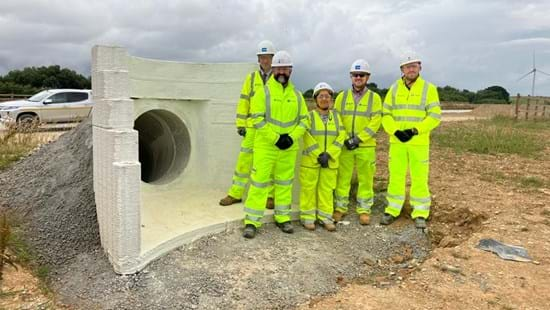As impressive as 3D printed houses may be, additive construction (AC) may have much larger implications beyond the field of housing. This is particularly true given the funding of the technology by such laws as the Bipartisan Infrastructure Act, as well as the general infrastructure needs in the face of extreme weather exacerbated by global warming. Therefore, projects such as a retaining wall recently produced by the University of Cambridge in the U.K. are of specific importance.
Researchers from Cambridge, working with engineering company Versarien, installed a headwall with embedded sensors on the A30 highway in Cornwall. These retaining walls are typically made with precast concrete made with formwork and steel reinforcement. With AC, the group was able to 3D print a curved hollow wall with no formwork, nor any steel reinforcement, as the unique geometry of the element allows it to reinforce itself. Standing at 2m (6 ft 6 in) high and 3m (9 ft 9 in) wide, the wall was printed in just one hour using a robotic arm-based printer at Versarien’s Gloucestershire headquarters.

The Department of Engineering’s Professor Abir Al-Tabbaa has spent the past six years developing sensors for monitoring the health of infrastructure, as well as self-healing concrete materials. In this project, the team integrated sensors into the wall that measure heat, humidity, pressure, strain, electrical resistivity, and electrochemical potential, which will inform the researchers about the reliability, robustness, accuracy, and longevity of the sensors.

Sensors embedded into the wall during printing.
Among the devices was a Piezoceramic Lead-Zirconate-Titanate (PZT) sensor for measuring electromechanical impedance response to indicate how 3D printed mortar hardens over time and the overall structure’s health. Eight of these were placed in the wall layers in different spots throughout the print to track load and strain throughout construction and service life.
Additionally, a LiDAR system was used to scan the structure as it was being printed to a digital twin of the wall. Her team also supplied sensors for measuring temperature during printing to detect potential hotspots, thermal gradients, or anomalies. This can then be matched against a thermal imaging profile to understand the thermal behavior of the wall. The team also developed a wireless data acquisition system for capturing data remotely.
“Since you need an extremely fast-setting cement for 3D printing, it also generates an enormous amount of heat. We embedded our sensors in the wall to measure temperature during construction, and now we’re getting data from them while the wall is on site,” said Al-Tabbaa. “Making the wall digital means it can speak for itself. And we can use our sensors to understand these 3D printed structures better and accelerate their acceptance in industry. This project will serve as a living laboratory, generating valuable data over its lifespan. The sensor data and ‘digital twin’ will help infrastructure professionals better understand how 3D printing can be used and tailored to print larger and more complex cement-based materials for the strategic road network.”
While digital twins for 3D printed infrastructure have been explored, they have yet to be widely implemented. In fact, the only example that comes to mind is the 3D printed metal bridge from MX3D installed in Amsterdam. However, with initiatives like the Advanced Digital Construction Management Systems grant program from the U.S. Department of Transportation, we’d expect a number of new projects in the vain of what Cambridge University has developed, not just limited to the U.S., but in Europe, China, and India, as well, where AC companies are making significant progress.
Subscribe to Our Email Newsletter
Stay up-to-date on all the latest news from the 3D printing industry and receive information and offers from third party vendors.
You May Also Like
Further Understanding of 3D Printing Design at ADDITIV Design World
ADDITIV is back once again! This time, the virtual platform for additive manufacturing will be holding the first-ever edition of ADDITIV Design World on May 23rd from 9:00 AM –...
3D Printer Maker EVO-tech Reborn as NEVO3D — Once More With Feeling
EVO-tech was a 3D printing service and original equipment manufacturer established in 2013 and based in Schörfling am Attersee, Austria. The company produced high-quality material extrusion systems featuring linear bearings,...
3D Systems Brings 3D Printed PEEK Cranial Implant to the U.S. with FDA Clearance
For more than 10 years, 3D Systems (NYSE:DDD) has worked hand-in-hand with surgeons to plan over 150,000 patient-specific cases, and develop more than two million instruments and implants from its...
CDFAM Returns to Berlin for Second Annual Symposium
The second CDFAM Computational Design Symposium is scheduled for May 7-8, 2024, in Berlin, and will convene leading experts in computational design across all scales. Building upon the first event...































